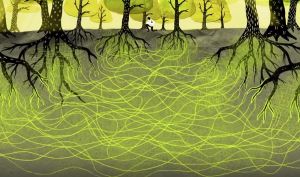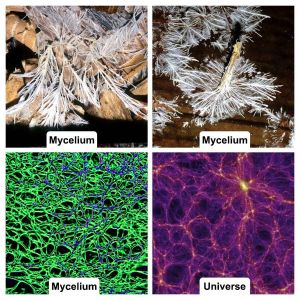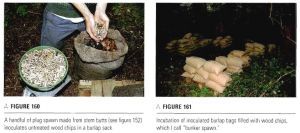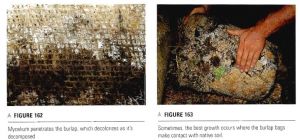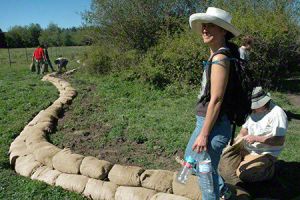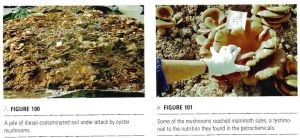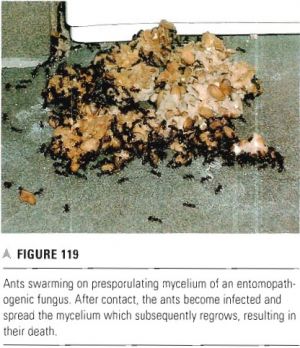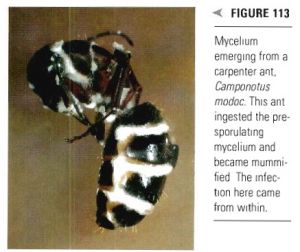Mycelium
Natural Intelligence
Understanding how mycelium works as an organism and the role it plays in our ecosystems has notably shaped how intelligence itself is defined.[1] As the neurological network of nature:
interlacing mosaics of mycelium infuse habitats with information-sharing membranes. These membranes are aware, react to change, and collectively have the long-term health of the host environment in mind. The mycelium stays in constant molecular communication with its environment, devising diverse enzymatic and chemical responses to complex challenges. [2]
The Mycelial archetype
Structures similar to mycelium can be seen throughout Mother Earth and the universe. Some structures resembling Mycelial networks include patterns of hurricanes, dark matter and the internet, further Mycelial networks resemble patterns predicted by string theory. [3]
Mycelium and the Environment
Habitats across the Earth depend upon Mycelium, a keystone species, to sustain themselves and their soils.[4] Mycelium hold soils together and help aerate them; Mycelium breaks down debris to build new blocks of soil after ecological catastrophes created by humans or otherwise.[5][6] Mycelial networks partner with bacteria and other microorganisms to break down organic material creating stronger structures of soil. [7]
Mycelial Highways
Mycelium, specifically mycorrhizal fungi, partner with plants, microbes, and other animals below ground through its vast Mycelial network. Through this so called Mycelial Highway, chemicals released by one organism are able to quickly reach other organisms, increasing overall communication and resistance between all. Furthermore nutrients and water are transferred between Mycelial networks to deficient organisms.[8][9]
The mycelia of fungal species that form exterior sheaths around the roots of partner plants are termed ectomycorrhizal. The mycorrhizal fungi that invade the interior root cells of host plants are labeled endomycorrhizal... Both plant and mycorrhizae benefit from the association. Because ectomycorrhizal mycelium grows beyond the plant's roots, it brings distant nutrients and moisture to the host plant, extending the absorption zone well beyond the root structure. The mycelium dramatically increases the plant's ingestion of nutrients, nitrogenous compounds, and essential elements (phosphorus, copper, and zinc) as it decomposes surrounding debris... Plants with mycorhizal fungal partners can also resist diseases far better than those without. Fungi benefit from the relationship because it gives them access to plant-secreted sugars, mostly hexoses that the fungi convert to mannitols, arabitols, and erythritols. [10]
Mycelial networks are able to transport nutrients between different species of trees:
In one experiment, researchers compared the flow of nutrients via the mycelium between 3 trees: a Douglas fir (Pseudotsuga menziesii), a paper birch (Betula papyrifera), and a western red cedar (Thuja plicata). The Douglas fir and paper birch shared the same ectomycorrhiza, while the cedar had an endomycorrhiza (VAM). The researchers covered the Douglas fir to simulate deep shade, thus lowering the tree's ability to photosynthesize sugars. In response, the mycorrhizae channeled sugars, tracked by radioactive carbon, from the root zone of the birch to the root zone of the fir. More than 9 percent of the net carbon compounds transferred to the fir orginiated from the birch's roots, while the cedar recieved only a smlla fraction. The amount of sugar transferred was directly proportional to the amount of shading. [11]
Building Materials
Mycelium has the potential to replace many building materials, but the efficacy largely depends on the type of mycelium used and the substrate the mycelium is growing on. Some studies have shown that mycelium grown on Hemp Shives has the potential to be used as building materials.[12]
Mycelium Bricks
https://www.certifiedenergy.com.au/emerging-materials/emerging-materials-mycelium-brick
MycoAgriculture
Mycelium can enhance food crop production in virtually all agroecology endeavors. Working with the proper fungal species based upon native soil ecologies and specific plant-fungal pairings should be handled with care to ensure the correct symbiotic relationship is established with the mycelium, food crops, and other wildlife/soil microbes.[13]
Mycorrhizal symbioses is a powerful tool to be employed in agroecological settings. Mycelium is highly efficient in facilitating plan nutrient uptake, water distribution and overall crop production.[14][15] Mycelium is able to increase Phosphorus and Nitrogen uptake and use efficiency,[16][17] which is vital in the transition away from Industrial Agriculture and artificial fertilizers. Mycelium can also help plants adapt to bioitic and abiotic stressors- increasing overall crop quality.[18][19]
Carbon Farming
Fungi store a third of carbon from fossil fuel emissions, with researchers calling in a new study to give them a greater role in carbon sequestration programs:
Professor Katie Field, Professor of Plant-Soil Processes at the University of Sheffield and co-author of the study, said:
“Mycorrhizal fungi represent a blind spot in carbon modelling, conservation, and restoration - the numbers we’ve uncovered are jaw-dropping, and when we’re thinking about solutions for climate we should also be thinking about what we can harness that exists already.[20]
Soil Bacteria
In 2017, a Nature Communications study reported that Mycelium-mediated transfer of water and nutrients stimulates bacterial activity in dry and low-nutrient environments:
"Fungal–bacterial interactions are highly diverse and contribute to many ecosystem processes... Our study provides direct experimental evidence for the stimulation of bacterial activity by mycelial supply of scarce resources in dry and nutrient-free environments. We propose that mycelia may stimulate bacterial activity and thus contribute to sustaining ecosystem functioning in stressed habitats."[21]
Mycorestoration
The science behind Mycelium as a mechanism for environmental restoration has not been researched in an extensive manner, likely because of Mycophobia, and has to be deployed with different climate regions in mind,[22] but this provides new possibilities of reversing the destructive effects of climate collapse.
Mycorestoration is the use of fungi to repair or restore the weakened immune systems of environments. Whether habitats have been damaged by human activity or natural disaster, saprophytic, endophytic, mycorrhizal, and in some cases parasitic fungi can aid recovery. As generations of mycelia cycle through a habitat, soil depth and moisture increase, enhancing the carrying capacity of the environment and the diversity of its members. [23]
Mycofiltration
Mycofiltration is the process of using Mycelium as a membrane to filter out microorganisms, pollutants, and silt.[24]
Habitats infused with mycelium reduce downstream particulate flow, mitigate erosion, filter out bacteria and protozoa, and modulate water flow through the soil. More than a mile of threadlike mycelial cells can infuse a gram of soil. These fine filaments function as a cellular net that catches particles and, in some cases, digests them. as the substrate debris is digested, microcavities form and fill with air or water, providing buoyant, aerobic infrastructures with vast surface areas. Water runnoff, rich in organic debris, percolates through the cellular mesh and is cleansed. When water is not flowing, the mycelium channels moisture from afar through its advancing fingerlike cells. [25]
Paul Stamets created a method of utilizing Mycelium to filter downstream water flows/ other sources of water; Using the Mycelium to filter out disease, fecal matter, and other contaminates. The method involves inoculating wood chips or straw bales with Mycelium and placing them around water sources or downstream from contaminated water sources; Choosing best suited strains of mycelium, is necessary, to target specific pathogen carrying insects, like mosquitos, or other contaminates: Staph, coliform, E-coli, and protozoa. [26]
Factory Farms
Factory Farms produce mass animal waste in high concentrations and contain toxic organisms/ disease including Pfiesteria, Listeria, Streptococcus, Escherichia coli, amoebic parasites, and other viruses.[27] [28] [29] A clear example of the threat factory farm waste production poses was when
hurricane Floyd hit North Carolina in 1999, the monsoon like rains caused dikes to burst and manure ponds to overflow, flooding thousands of acres with animal feces and causing incalculable health problems both on and off the farms. Residents in Charlotte were rudely awakened to the enormity of the problems by the fouling on their doorsteps. Filth filled the streets and flooded basements. The collateral damage included contaminated wells, fisheries, and crops. Many diseases spread, including ones pathologists are still at a loss to identify...[30]
Factory Farm waste production also pose risks to Indigenous communities. On the Santee Sioux Reservation cattle ranches produce waste, containing fecal coliform bacteria, which accumulate in septic ponds and leaches into the communities water source. The contaminates from the ranches have made the water undrinkable on the reservation. [31]
Mycelium offers unique solutions to water contamination:
A variety of forms of mycelial mats can prevent downstream pollution. I am keen on using bunker spawn-mycelium in burlap sacks- to build mycelial buffers to capture microbes and nutrients...[32]
Installing a Mycofilter
Paul Stamets explains how easily a mycofiltration system can be installed to help filter contaminates on farmland:
A gently sloped area below a feeding lot or manure pond, where effluent from the lot or pond continually seeps through, is an ideal site to install a mycofilter, essentially a myceliated organic drain field. For the bottom layer, scatter sawdust or wood chips to a depth of 3 to 4 inches. For the first of 2 layers of spawn, on top of the sawdust or wood chips, spread inoculated sawdust by hand or by silage spreader; use 1/4 pound inoculated sawdust per square foot of the site. Next, add a layer of corncobs 4 inches deep, and follow with a second layer of spawn. because high winds and harsh sun can dry out mycofiltration beds, cover the site with waste cardboard before adding the last layer of straw. The finish layer of straw should be 4 to 6 inches deep to provide shade, aeration, and moisture to layers below. (If natural rains do not provide sufficient moisture, sprinklers can be set up for the first few weeks until the site becomes charged with mycelia.) The surface area of the mycofilter should be at least several times larger than the surface area of the manure pond of feeding lot, depending upon depths, slope, and flows.
Mycofilters are best built in the early spring. Once established, the mycofilter will mature in a few months and remain viable for years, provided that fresh organic debris is periodically added to the top layer and covered with more straw. For some, the best time for this may be after the fall harvests, when agricultural debris is plentiful. After some time, red worms will arrive and transform the mycelium, cardboard, and debris into rich soil. every 2 to 3 years, the newly emerging material can be scooped up using a front loader tractor and used elsewhere as soil; the timing of this cycle will vary. (Incidentally, gourmet mushrooms may form after rains depending upon temperatures. These mushrooms "reseed" the beds, provided there is enough food.)...
... I encourage farmers to try this method. The amount of time to install a mycofilter is minimal, only a couple hours. Spawn will probably be your biggest expense, but once established and cared for, the mycelium can regenerate itself until the debris base has been reduced to soil. As these areas mature, they usually become covered with native grasses, which also play remediative roles. A universe of compatible organisms shares this habitat, with mushroom mycelia reigning as the pioneering organisms.[33]
Burlap Bunker Spawn
Paul Stamets created a method of Mycofiltration utilizing Burlap bags filled with mycelium spawn and other organic materials such as wood chips. The burlap sacks can then be placed between different environments and aid in the filtering of contaminates and other small organic matter. The burlap sacks also aid in the prevention of erosion.
Immediately upon construction, these spawn bags filter biological or chemical wastes and prevent downstream contamination due to the uncolonized wood chips' extensive surface areas and absorptive abilities. As the mycelium grows, its net-like cells increasingly trap silt and bacteria, and the "sweat" of the mycelium denatures many toxins, both chemical and biological. Upon colonization, a burlap bag of spawn (now weighing 30 to 60 pounds) becomes a mycofiltration vessel that can also be put to work for habitat restoration or can be staged for further expansion of mycelium into more wood chip-filled burlap sacks.[34]
Mycoforestry
Mycoforestry is the use of fungi/mycelium to sustain forest communities; The potential benefits include: preservation of native forests, recovery and recycling of woodland debris, enhancement of replanted trees, strengthening sustainability of ecosystems, and economic diversity.[35] Mycelium can also aid in recovery after forest fires.[36] The timber industry poses a serious risk to old growth forests and other forests in general:
With each generation of trees we cut, soils increasingly shallow and we further jeopardize the health of forests. The richness and depth of soil is our legacy from centuries of mycelial activity. And with each harvesting and replanting, the soil loses nutrients and gradually becomes overtaxed, no longer able to support the growth of healthy trees. Trees prematurely climax, falling over as the root wads can't hold the trees upright. Current "sustainable" logging practices strive to balance the impact of over harvesting with ecological restoration, potentially irreconcilable objectives. The bottom line is that we need to focus on carbon cycles and raise the nutritional plateau in timberlands by accelerating decomposition of wood debris and restarting plant cycles.[37]
When forests are clear cut the mycorrhizal fungal communities die back and decomposition of the left over debris slows down, which in turn hinders habitat recovery. Making clear cut debris fields more mycelial friendly helps speed up and balance the decomposition cycle; Making the fields more mycelial friendly involves bringing saprophytic and other fungi into close contact with the debris. The size of forest debris affects the inoculation rate of mycelium, Paul Stamets suggests:
... creating a matrix by chipping wood into variably sized fragments in order to let mycelium quickly grab and invade the wood. Wood fragments with greater surface areas are more likely to have contact with spores or mycelium; this is especially true in the cultivation of mushrooms, where spawn growth is integral to success. The fungal recycling of wood chips lessens reliance on fertilizers, herbicides, and pesticides. So leaving the chips in the woods helps recovering forest soils just like leaving stubble on farmed land helps agricultural soil.[38]
Climate Adaptation
In 2019, the €3 million LIFE MycoRestore research project was launched to study the "Innovative use of mycological resources for resilient & productive Mediterranean forests threatened by climate change." Receiving the majority of its funding from the European Union,
LIFE MycoRestore seeks to utilize diverse mycological resources and forest management practices to contribute to the biological resilience of Mediterranean forests. It also aims at generating new income sources and ensuring the stability of forest ecosystem services while addressing the effects of climate change. The projects main objectives are to:
- Demonstrate sustainable mycological and forestry management practices to increase forest resistance to fires and drought (MycoForestry);
- Promote green jobs in rural economies based on wood processing and innovative high-value mushroom products.
The project will demonstrate a circular economy approach to mushroom and substrate production supply chains (MycoEconomy) and provide proof of concept on the use of natural myco-control products and native fungal species for reduced pest/pathogen presence in forests (MycoControl).[39]
Mycoremediation
Mycoremediation is the use of fungi to degrade or remove toxins from the environment.
Mycoremediation practices involve mixing mycelium into contaminated soil, placing mycelial mats over toxic sites, or a combination of these techniques, in onetime or successive treatments[40]
Mycelium acts as a catalyst for other animals, bacteria and plants to populate sites of contamination to break down toxic chemicals and contaminates.
The powerful enzymes secreted by certain fungi digest lignin and cellulose, the primary structural components of wood. These digestive enzymes can also break down a surprisingly wide range of toxins that have chemical bonds like those in wood... These complex mixtures allow the mycelium to dismantle some of the most resistant materials made by humans or nature. Since many of the bonds that hold plant material together are similar to the bonds found in petroleum products, including diesel, oil, and many herbicides and pesticides, mycelial enzymes are well suited for decomposing a wide spectrum of durable toxic chemicals. Because the mycelium breaks the hydrogen-carbon bonds, the primary nonsolid byproducts are liberated in the form of water and carbon dioxide. More than 50 percent of the organic mass cleaves off as carbon dioxide and 10 to 20 percent as water; this is why compost piles dramatically shrink and ooze leachate and they mature.[41]
Oil Spills
In Washington Paul Stamets conducted an experiment at a maintenance yard used by the Washington State Department of Transportation in Bellinghman, Washington. The site was contaminated with diesel and oil at levels approaching 20,000 parts per million of total aromatic hydrocarbons. The department of transportation
...set aside 4 piles of diesel-contaminated soil... ...Each pile measured about 3 to 4 feet in height, 20 feet in length, and 8 feet in width. Into one of the piles (measuring about 10 cubic yards), we mixed about 3 cubic yards of pure culture sawdust spawn, an amount roughly equal to 30 percent of the pile. We placed the spawn in layers, sandwiching the soil in between... ...The other piles received no mycelia. Of these, 2 were given bacterial treatments and 1 was an untreated control. Our myceliated pile was covered with shade cloth, while black plastic tarps were pulled over the other piles to keep out rain. Approximately 4 weeks later, part of our team returned to the piles and pulled back the tarps on the non-mycelium-treated dirt. All 3 of the piles were black and lifeless and stank like diesel and oil.[42]
The pile of soil inoculated with the sawdust mycelium spawn was covered in oyster mushrooms, the soil was light brown and no longer smelled of diesel and oil. For five weeks the mushrooms continued to fruit, lay spores, and then died back, during fruiting/ sporulating period,
...they attracted insects that feasted upon the succulent fruiting bodies and laid their eggs in them. Soon squirming larvae attracted birds, which brought seeds and turned our pile into an oasis of life. (Seeds may have also blown in with the wind.) Other mushroom species-secondary decomposers- appeared as the pile's biosphere diversified. When mushrooms rotted, bacteria and predator fungi rose to the occasion.[43]
Experiments of this nature show the potential of mycelium to help regenerate the environment- reversing the destructive effects of fossil fuels and capitalism.
Mycopesticides
Mycelium has the potential to replace traditional chemical pesticides, which cause great harm to the environment. Chemical pesticides, while killing the target insect, also harm non-targeted organisms, pollute water, and impair human health.[44][45] Since the 1990's there have been several patents issued pertaining to fungi as a pesticide, but more research is still needed, because many insects such as carpenter ants have safeguards in place to prevent other ants from entering the colony if they are covered in mushroom spores.
Genus of fungi/mycelium that have garnered attention include Metarhizium, a green mold fungus highly prevalent in soils, Beauveria, and some species in the genus Paecilomyces.[46] Paul Stamets recieved a patent on December 9, 2003, for his breakthrough research of presporulating fungi, which attracts and kills Formosan termites (Coptotermes formosanus), eastern subterranean termites (Reticulitermes flavipes), and carpenter ants (Camponotus species). On October 17, 2006 he was awarded a second patent for controlling all social insects, which are estimated to be nearly 200,000 species.[47]
A 2009 study catalyzed by the danger of evolving insecticide resistance in malaria-transmitting mosquitos investigated the value of the fungi Beauveria bassiana as a mycopesticide:
Four different mosquito strains with high resistance levels against pyrethroids, organochlorines, or carbamates were equally susceptible to B. bassiana infection as their baseline counterparts, showing significantly reduced mosquito survival. Moreover, fungal infection reduced the expression of resistance to the key public health insecticides permethrin and dichlorodiphenyltrichloroethane. Mosquitoes preinfected with B. bassiana or Metarhizium anisopliae showed a significant increase in mortality after insecticide exposure compared with uninfected control mosquitoes. Our results show a high potential utility of fungal biopesticides for complementing existing vector control measures and provide products for use in resistance management strategies.[48]
No Till Farming
Industrial till-based farming requires a massive input of fertilizers, pesticides, and insecticides.[49] Dr. Vandana Shiva comments on the inefficency of these inputs and outputs:
Industrial agriculture is an inefficient and wasteful system which is chemical intensive, fossil fuel intensive and capital intensive. It destroys nature’s capital on the one hand and society’s capital on the other, by displacing small farms and destroying health. It uses 10 units of energy as input to produce one unit of energy as food. This waste is amplified by anther factor of ten when animals are put in factory farms and fed grain, instead of grass in free range ecological systems, Rob Johnston celebrates these animal prisons as efficient, ignoring the fact that it takes 7 kg of grain to produce one kg of beef, 4kg of grain to produce 1 kg of pork and 2.4 kg of grain to produce 1 kg of chicken... [50]
Mycelium in conjunction with organic no till farming reduces the input of artificial fertilizers and pesticides/insecticides, while increasing the overall productivity of farmland. Additionally, no till farming involving mycelium increases drought resistance, builds healthy diversely populated soils, aerates soils, and makes soils/crops more resistant to extreme temperatures and disease. Furthermore, no till farming practices decrease organic carbon release by 41 percent versus tilling soils. [51] [52]
Indigenous Uses
There are at least two known examples of Indigenous Nations using Mycelium in textiles. One example is a Tlingit Wall Pocket from Ketchikan, Alaska made in 1903. This has been in the Hood Museum of Art storage at Dartmouth College for over 60 years. [53]
Indigenous nations in Cascadia in the so called United States used mushrooms for a variety of things including dyes, tinder, medicine, and paint. The Indigenous Nations of the Pacific Northwest, the Cree Nation, the Nuxalk Nation, among others discovered the medicinal values of mushrooms/myeclium independently. In addition to the material use of mushrooms, some types, including Agarikon (omitopsis Officinalis Sporophores,) were sacred to the Tlingit, Haida, Tsimshian, among other Pacific Northwest nations.
The perennial basidiocarps were recognized by the Indigenous Peoples of the Northwest Coast as objects with supernatural powers and were used during the shaman's life in various society rituals. After the death of a shaman, these carved sporophores were placed as guardians at the head of the grave.[54]
As is the case for many sacred items from various Indigenous Nations across the so called United States and Canada[55][56]
Collectors for various museums obtained these carved objects in the late 1800s, and they have been displayed or stored in various museum collections since that time.[57]
Mycophobia
The fear of mycelium (typically implicit) as usually manifested through a fear of their fruiting bodies (mushrooms) is known as mycophobia.
Pyrolize
"This Underground Economy Exists in a Secret Fungi Kingdom" (https://www.youtube.com/watch?v=WWD_1Nq6iwQ)
"Fungal Banking with Biochar and Hugelkultur" (https://www.youtube.com/watch?v=EoKS07Y1ASk)
"The Organic Internet of a Mycelium Network: Suzanne Simard, Paul Stamets, and Terence Mackenna" (https://www.youtube.com/watch?v=rGyECGJqWDU)
Related
Cited
- ↑ https://microdose-journey.com/mycelium-networks/
- ↑ Mycelium Running, by Paul Stamets
- ↑ Paul Stamets, Mycelium Running, Page 9
- ↑ https://www.nature.com/articles/s41598-019-43980-3
- ↑ https://nph.onlinelibrary.wiley.com/doi/full/10.1111/j.1469-8137.2006.01750.x
- ↑ Andrew W. Claridge, James M. Trappe, Karen Hansen, Do fungi have a role as soil stabilizers and remediators after forest fire?, Forest Ecology and Management, Volume 257, Issue 3, 2009, Pages 1063-1069, ISSN 0378-1127, https://doi.org/10.1016/j.foreco.2008.11.011.
- ↑ Paul Stamets, Mycelium Running, Page 11
- ↑ https://www.cell.com/trends/plant-science/fulltext/S1360-1385(12)00133-1?_returnURL=https%3A%2F%2Flinkinghub.elsevier.com%2Fretrieve%2Fpii%2FS1360138512001331%3Fshowall%3Dtrue
- ↑ https://www.sciencedirect.com/science/article/abs/pii/S0960852409015764
- ↑ Paul Stamets, Mycelium Running, Page 24
- ↑ Paul Stamets, Mycelium Running, Page 24-26
- ↑ Zimele, Z., Irbe, I., Grinins, J., Bikovens, O., Verovkins, A. et al. (2020). Novel Mycelium-Based Biocomposites (MBB) as Building Materials. Journal of Renewable Materials, 8(9), 1067–1076.
- ↑ https://www.nature.com/articles/ismej2014207
- ↑ Smith, S.E.; Read, D.J. Mycorrhizal Symbiosis, 2nd ed.; Academic Press: London, UK, 1997; ISBN 9780080559346.
- ↑ Van der Heijden, M.G.A.; Klironomos, J.N.; Ursic, M.M.; Moutoglis, P.; Streitwolf-Engel, R.; Boller, T.; Wiemken, A.; Sanders, I.R. Mycorrhizal fungal diversity determines plant biodiversity, ecosystem variability and productivity. Nature 1998, 396, 69–72.
- ↑ Hill, J.O.; Simpson, R.J.; Ryan, M.H.; Chapman, D.F. Root hair morphology and mycorrhizal colonisation of pasture species in response to phosphorus and nitrogen nutrition. Crop. Past Sci. 2010, 61, 122–131.
- ↑ Trinchera, A.; Testani, E.; Ciaccia, C.Q.; Campanelli, G.; Leteo, F.; Canali, S. Effects induced by living mulch on rhizosphere interactions in organic artichoke: The cultivar’s adaptive strategy. Renew. Agr. Food Syst. 2016, 32, 214–223.
- ↑ Miceli, A.; Romano, C.; Moncada, A.; Piazza, G.; Torta, L.; D’Anna, F.; Vetrano, F. Yield and quality of mini-watermelon as affected by grafting and mycorrhizal inoculum. J. Agr. Sci. Tech. 2016, 18, 505–516.
- ↑ Salvioli, A.; Novero, M.; Lacourt, I.; Bonfante, P. The Impact of Mycorrhizal Symbiosis on Tomato Fruit Quality. In Proceedings of the 16th IFOAM Organic World Congress, Modena, Italy, 16–20 June 2008
- ↑ https://www.eurekalert.org/news-releases/991288
- ↑ https://www.nature.com/articles/ncomms15472
- ↑ https://www.mdpi.com/2073-4441/10/9/1226/htm
- ↑ Paul Stamets, Mycelium Running, Page 55
- ↑ https://assets.fungiperfecti.net/pdf/articles/Fungi_Perfecti_Phase_I_Report.pdf
- ↑ Paul Stamets, Mycelium Running, Page 58
- ↑ https://www.sciencedirect.com/science/article/abs/pii/S0925857414002250
- ↑ https://ehp.niehs.nih.gov/doi/pdf/10.1289/ehp.02110445
- ↑ Paul Stamets, Mycelium Running, Page 63
- ↑ https://branchoutnow.org/coronavirus-and-the-climate-a-singular-crisis/
- ↑ Paul Stamets, Mycelium Running, Page 63-64
- ↑ https://branchoutnow.org/growing-sovereignty-part-2-regenerating-sacred-water/
- ↑ Paul Stamets, Mycelium Running, Page 64
- ↑ Paul Stamets, Mycelium Running, Page 68
- ↑ Paul Stamets, Mycelium Running, Page 151
- ↑ Paul Stamets, Mycelium Running, Page 69
- ↑ Andrew W. Claridge, James M. Trappe, Karen Hansen, Do fungi have a role as soil stabilizers and remediators after forest fire?, Forest Ecology and Management, Volume 257, Issue 3, 2009, Pages 1063-1069, ISSN 0378-1127,https://doi.org/10.1016/j.foreco.2008.11.011.
- ↑ Paul Stamets, Mycelium Running, Page 72
- ↑ Paul Stamets, Mycelium Running, Page 73
- ↑ https://climate-adapt.eea.europa.eu/en/metadata/projects/innovative-use-of-mycological-resources-for-resilient-productive-mediterranean-forests-threatened-by-climate-change
- ↑ Paul Stamets, Mycelium Running, Page 86
- ↑ Paul Stamets, Mycelium Running, Page 87-88
- ↑ Paul Stamets, Mycelium Running, Page 92
- ↑ Paul Stamets, Mycelium Running, Page 92
- ↑ Paul Stamets, Mycelium Running, Page 116
- ↑ https://www.sciencedirect.com/science/article/pii/S0269749120362692
- ↑ Paul Stamets, Mycelium Running, Page 117
- ↑ Paul Stamets, Mycelium Running, Page 122
- ↑ https://www.pnas.org/doi/10.1073/pnas.0908530106
- ↑ https://ehp.niehs.nih.gov/doi/pdf/10.1289/ehp.02110445
- ↑ https://wilderutopia.com/health/vandana-shiva-industrial-agriculture-destroys-life/
- ↑ Paul Stamets, Mycelium Running, Page 65-66
- ↑ https://www.usda.gov/media/blog/2017/11/30/saving-money-time-and-soil-economics-no-till-farming
- ↑ https://doi.org/10.1080/00275514.2020.1858686
- ↑ Robert A. Blanchette, Brian D. Compton, Nancy J. Turner & Robert L. Gilbertson (1992) Nineteenth Century Shaman Grave Guardians are Carved Fomitopsis Officinalis Sporophores, Mycologia, 84:1, 119-124, DOI: 10.1080/00275514.1992.12026114
- ↑ https://www.macleans.ca/culture/canadas-museums-are-slowly-starting-to-return-indigenous-artifacts/
- ↑ https://www.washingtonpost.com/history/2022/07/17/stolen-wounded-knee-artifacts-native-americans/
- ↑ Robert A. Blanchette, Brian D. Compton, Nancy J. Turner & Robert L. Gilbertson (1992) Nineteenth Century Shaman Grave Guardians are Carved Fomitopsis Officinalis Sporophores, Mycologia, 84:1, 119-124, DOI: 10.1080/00275514.1992.12026114

